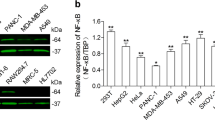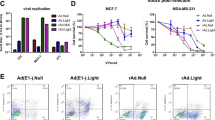Abstract
Conditionally replicative adenovirus (CRAD) is an attractive anticancer agent as it can selectively replicate in tumor cells. Expression of telomerase reverse transcriptase (TERT) is a unique tumor cell characteristic, being absent in normal postmitotic cells. Thus, we constructed a TERT promoter regulated CRAD for tumor-specific oncolysis by replacing the endogenous adenovirus E1A promoter with that of human TERT (Adv-TERTp-E1A). We showed that its replication was severely attenuated in TERT-negative cells, but that it replicated almost as efficiently as wild-type adenovirus in TERT-positive cells. Accordingly, Adv-TERTp-E1A conferred cytopathicity to TERT-positive, but not TERT-negative, cells. In vivo replication of Adv-TERTp-E1A after local administration into a xenograft model of human hepatocellular carcinoma in nude mice was demonstrated by an increase in adenovirus titers in tumor extracts by several orders of magnitude between 6 h and 3 days postvector injection. Furthermore, significant inhibition of tumor growth with substantial necrotic tumor areas staining positively for adenovirus was observed with Adv-TERTp-E1A, but not with a control replication-deficient adenovirus. There was also the absence of hepatotoxicity in tumor-bearing animals after intratumoral delivery of the CRAD. The results indicate that the TERT promoter-driven CRAD is capable of tumor-selective replication and oncolysis in vitro and in vivo, and can be utilized as an adjuvant treatment agent for cancer.
This is a preview of subscription content, access via your institution
Access options
Subscribe to this journal
Receive 12 print issues and online access
$259.00 per year
only $21.58 per issue
Buy this article
- Purchase on Springer Link
- Instant access to full article PDF
Prices may be subject to local taxes which are calculated during checkout







Similar content being viewed by others
References
Kirn D . Replication-selective oncolytic adenoviruses: virotherapy aimed at genetic targets in cancer. Oncogene 2000; 19: 6660–6669.
Alemany R, Balague C, Curiel DT . Replicative adenoviruses for cancer therapy. Nat Biotechnol 2000; 18: 723–727.
Bischoff JR et al. An adenovirus mutant that replicates selectively in p53-deficient human tumor cells. Science 1996; 274: 373–376.
Heise C et al. An adenovirus E1A mutant that demonstrates potent and selective systemic anti-tumoral efficacy. Nat Med 2000; 6: 1134–1139.
Reid T et al. Intra-arterial administration of a replication-selective adenovirus (dl1520) in patients with colorectal carcinoma metastatic to the liver: a phase I trial. Gene Therapy 2001; 8: 1618–1626.
Leppard KN, Shenk T . The adenovirus E1B 55 kd protein influences mRNA transport via an intranuclear effect on RNA metabolism. EMBO J 1989; 8: 2329–2336.
Shen Y et al. Analyses of single-amino-acid substitution mutants of adenovirus type 5 E1B-55 K protein. J Virol 2001; 75: 4297–4307.
Takahashi M et al. E1B-55K-deleted adenovirus expressing E1A-13S by AFP-enhancer/promoter is capable of highly specific replication in AFP-producing hepatocellular carcinoma and eradication of established tumor. Mol Ther 2002; 5: 627–634.
Kurihara T, Brough DE, Kovesdi I, Kufe DW . Selectivity of a replication-competent adenovirus for human breast carcinoma cells expressing the MUC1 antigen. J Clin Invest 2000; 106: 763–771.
Yu DC et al. The addition of adenovirus type 5 region E3 enables calydon virus 787 to eliminate distant prostate tumor xenografts. Cancer Res 1999; 59: 4200–4203.
Yu DC et al. Antitumor synergy of CV787, a prostate cancer-specific adenovirus, and paclitaxel and docetaxel. Cancer Res 2001; 61: 517–525.
Hernandez-Alcoceba R, Pihalja M, Wicha MS, Clarke MF . A novel, conditionally replicative adenovirus for the treatment of breast cancer that allows controlled replication of E1a-deleted adenoviral vectors. Hum Gene Ther 2000; 11: 2009–2024.
De weese TL et al. A phase I trial of CV706, a replication-competent, PSA selective oncolytic adenovirus, for the treatment of locally recurrent prostate cancer following radiation therapy. Cancer Res 2001; 61: 7464–7472.
Shay JW, Zou Y, Hiyama E, Wright WE . Telomerase and cancer. Hum Mol Genet 2001; 10: 677–685.
Ulaner GA et al. Telomerase activity in human development is regulated by human telomerase reverse transcriptase (hTERT) transcription and by alternate splicing of hTERT transcripts. Cancer Res 1998; 58: 4168–4172.
Hara H et al. Clinicopathologic significance of telomerase activity and hTERT mRNA expression in non-small cell lung cancer. Lung Cancer 2001; 34: 219–226.
Kawakami Y et al. Immuno-histochemical detection of human telomerase reverse transcriptase in human liver tissues. Oncogene 2000; 19: 3888–3893.
Rathi A et al. Telomerase RNA expression during progression of gastric cancer. Hum Pathol 1999; 30: 1302–1308.
Saito K et al. Gene expression for suppressors of telomerase activity (telomeric-repeat binding factors) in breast cancer. Jpn J Cancer Res 2002; 93: 253–258.
Ito H et al. Detection of human telomerase reverse transcriptase messenger RNA in voided urine samples as a useful diagnostic tool for bladder cancer. Clin Cancer Res 1998; 4: 2807–2810.
Takakura M et al. Cloning of human telomerase catalytic subunit (hTERT) gene promoter and identification of proximal core promoter sequences essential for transcriptional activation in immortalized and cancer cells. Cancer Res 1999; 59: 551–557.
Hahn WC et al. Inhibition of telomerase limits the growth of human cancer cells. Nat Med 1999; 5: 1164–1170.
Gu J, Andreeff M, Roth JA, Fang B . hTERT promoter induces tumor-specific Bax gene expression and cell killing in syngenic mouse tumor model and prevents systemic toxicity. Gene Therapy 2002; 9: 30–37.
Majumdar AS et al. The telomerase reverse transcriptase promoter drives efficacious tumor suicide gene therapy while preventing hepatotoxicity encountered with constitutive promoters. Gene Therapy 2001; 8: 568–578.
Savontaus MJ, Sauter BV, Huang TG, Woo SL . Transcriptional targeting of conditionally replicating adenovirus to dividing endothelial cells. Gene Therapy 2002; 9: 972–979.
Goodwin EC, DiMaio D . Induced senescence in HeLa cervical carcinoma cells containing elevated telomerase activity and extended telomeres. Cell Growth Differ 2001; 12: 525–534.
Ogretmen B et al. Molecular mechanisms of ceramide-mediated telomerase inhibition in the A549 human lung adenocarcinoma cell line. J Biol Chem 2001; 276: 32506–32514.
Abdul-Ghani R et al. Use of transcriptional regulatory sequences of telomerase (hTER and hTERT) for selective killing of cancer cells. Mol Ther 2000; 2: 539–544.
Hernandez-Alcoceba R, Pihalja M, Qian D, Clarke MF . New oncolytic adenoviruses with hypoxia- and estrogen receptor-regulated replication. Hum Gene Ther 2002; 13: 1737–1750.
Heise C et al. ONYX-015, an E1B gene-attenuated adenovirus, causes tumor-specific cytolysis and antitumoral efficacy that can be augmented by standard chemotherapeutic agents. Nat Med 1997; 3: 639–645.
Khuri FR et al. A controlled trial of intratumoral ONYX-015, a selectively replicating adenovirus, in combination with cisplatin and 5-fluorouracil in patients with recurrent head and neck cancer. Nat Med 2000; 6: 879–885.
Lamont JP et al. A prospective phase II trial of ONYX-015 adenovirus and chemotherapy in recurrent squamous cell carcinoma of the head and neck (the Baylor experience). Ann Surg Oncol 2000; 7: 588–592.
Vasey PA et al. Phase I trial of intraperitoneal injection of the E1B-55-kd-gene-deleted adenovirus ONYX-015 (dl1520) given on days 1 through 5 every 3 weeks in patients with recurrent/refractory epithelial ovarian cancer. J Clin Oncol 2002; 20: 1562–1569.
Acknowledgements
This work was supported in part by a Department of Defense Grant DAMD17-01-1–0336. We thank Drs. Shu-Hsia Chen and Simon Hall for helpful and constructive discussions, and Ms Jenny Suriawinata for technical assistance.
Author information
Authors and Affiliations
Rights and permissions
About this article
Cite this article
Huang, TG., Savontaus, M., Shinozaki, K. et al. Telomerase-dependent oncolytic adenovirus for cancer treatment. Gene Ther 10, 1241–1247 (2003). https://doi.org/10.1038/sj.gt.3301987
Received:
Accepted:
Published:
Issue Date:
DOI: https://doi.org/10.1038/sj.gt.3301987
Keywords
This article is cited by
-
Oncolytic viruses: adenoviruses
Virus Genes (2017)
-
Native musk and synthetic musk ketone strongly induced the growth repression and the apoptosis of cancer cells
BMC Complementary and Alternative Medicine (2016)
-
Meganuclease-mediated Virus Self-cleavage Facilitates Tumor-specific Virus Replication
Molecular Therapy (2013)
-
Oncolytic Viruses in the Treatment of Cancer: A Review of Current Strategies
Pathology & Oncology Research (2012)
-
Oncolytic Adenovirus Expressing Soluble TGFβ Receptor II-Fc-mediated Inhibition of Established Bone Metastases: A Safe and Effective Systemic Therapeutic Approach for Breast Cancer
Molecular Therapy (2011)



